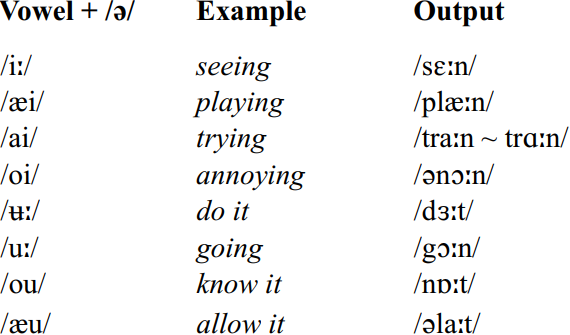


 Grammar
Grammar
 Tenses
Tenses
 Present
Present
 Past
Past
 Future
Future
 Parts Of Speech
Parts Of Speech
 Nouns
Nouns
 Verbs
Verbs
 Adverbs
Adverbs
 Adjectives
Adjectives
 Pronouns
Pronouns
 Pre Position
Pre Position
 Preposition by function
Preposition by function 
 Preposition by construction
Preposition by construction
 Conjunctions
Conjunctions
 Interjections
Interjections
 Grammar Rules
Grammar Rules
 Linguistics
Linguistics
 Semantics
Semantics
 Pragmatics
Pragmatics
 Reading Comprehension
Reading Comprehension|
Read More
Date: 2024-03-11
Date: 2024-05-08
Date: 2024-04-22
|
Smoothing
We have already noted that earlier ingliding diphthongs have become monophthongs:  in near, /εə/ > /ε:/ in square. This is also true of
in near, /εə/ > /ε:/ in square. This is also true of  in poor,
in poor,  in pore, and (presumably)
in pore, and (presumably)  in pure. This development has also occurred in original triphthongs, giving tower /ta:/ and fire /fa:/ in working-class speech – the vowel /a:/ occurs only as a result of smoothing. In middle class speech, however, in which /a:/ is more central, /a:/ does not occur, and tar and tower are homophonous.
in pure. This development has also occurred in original triphthongs, giving tower /ta:/ and fire /fa:/ in working-class speech – the vowel /a:/ occurs only as a result of smoothing. In middle class speech, however, in which /a:/ is more central, /a:/ does not occur, and tar and tower are homophonous.
This historical process involving lowering before /ə/ and then loss of /ə/ is paralleled by a synchronic phonological process which carries across morpheme and word boundaries, and extends to additional vowels. (In examining the following examples, recall that East Anglia has /ə/ in most unstressed syllables where many other accents have  .) The full facts can be summarized as follows:
.) The full facts can be summarized as follows:

Thus, do it is homophonous with dirt and going rhymes with lawn. The vowels /æ:/, /a:/,  occur only as a result of smoothing. Interestingly, some speakers in Norwich pronounce towel as /tз:l/. Smoothing is most typical of the northern zone of East Anglia, but is currently spreading southwards (Trudgill 1986).
occur only as a result of smoothing. Interestingly, some speakers in Norwich pronounce towel as /tз:l/. Smoothing is most typical of the northern zone of East Anglia, but is currently spreading southwards (Trudgill 1986).
|
|
|
|
تحذير من "عادة" خلال تنظيف اللسان.. خطيرة على القلب
|
|
|
|
|
|
|
دراسة علمية تحذر من علاقات حب "اصطناعية" ؟!
|
|
|
|
|
|
|
العتبة العباسية المقدسة تحذّر من خطورة الحرب الثقافية والأخلاقية التي تستهدف المجتمع الإسلاميّ
|
|
|